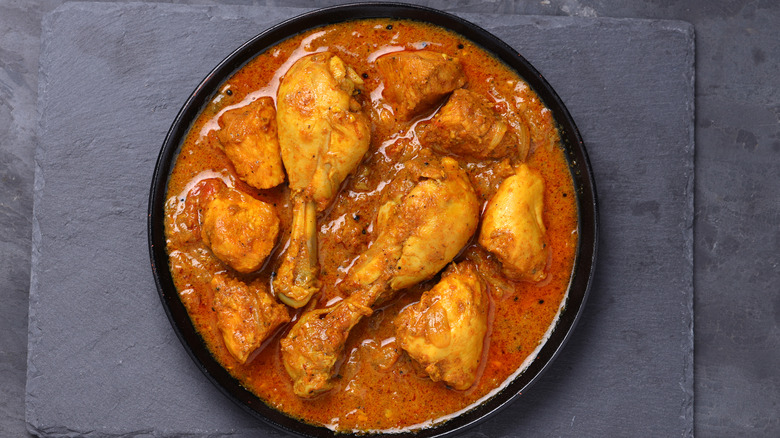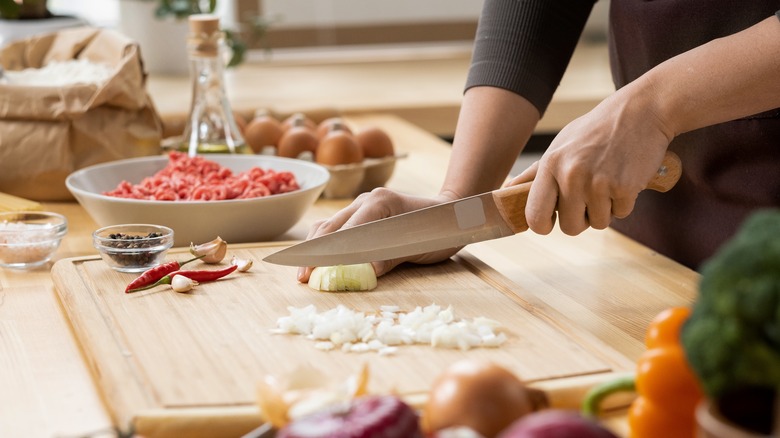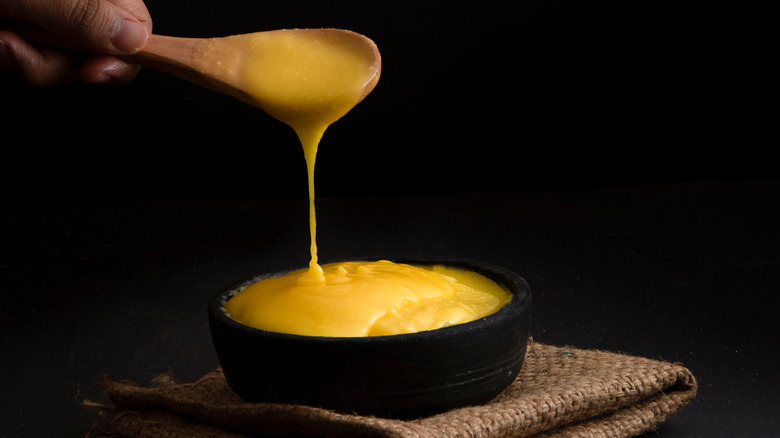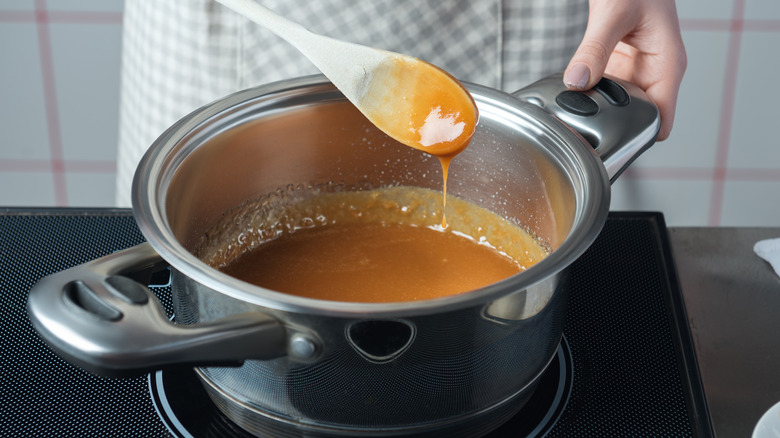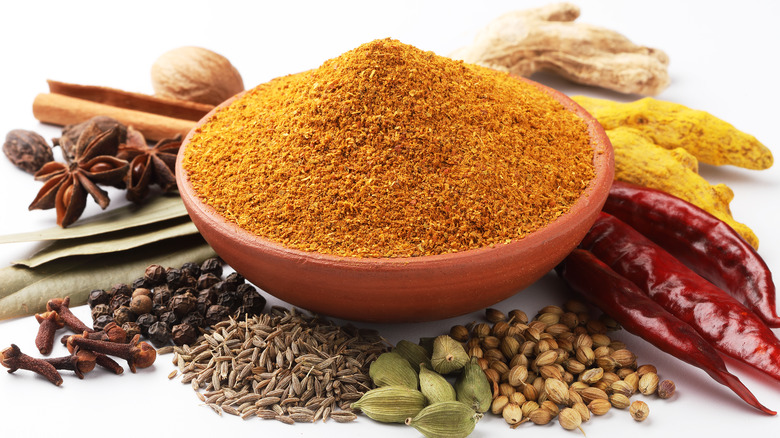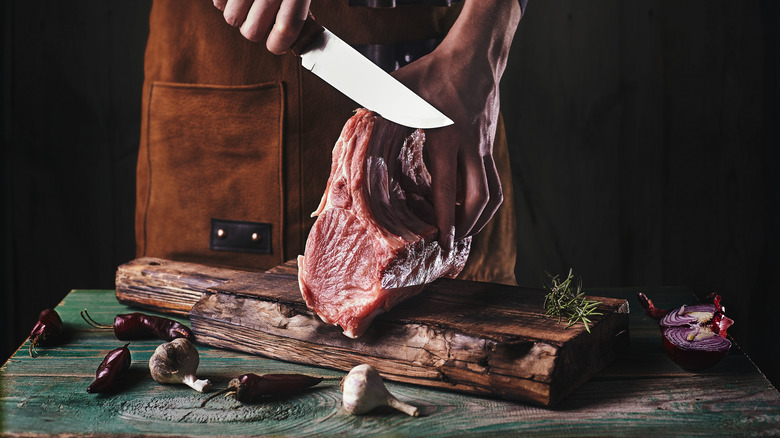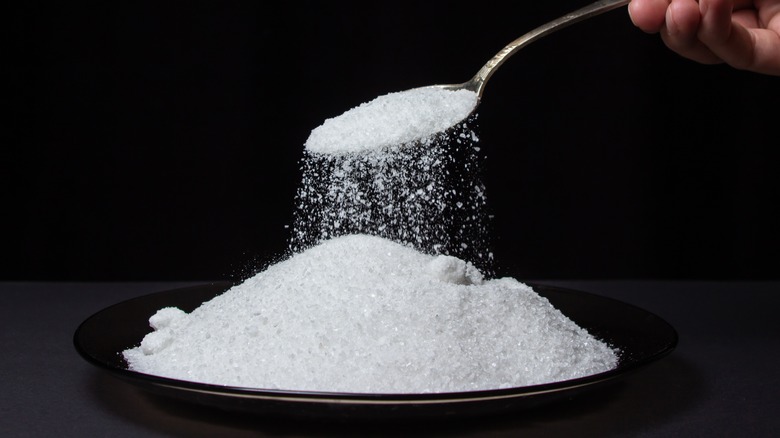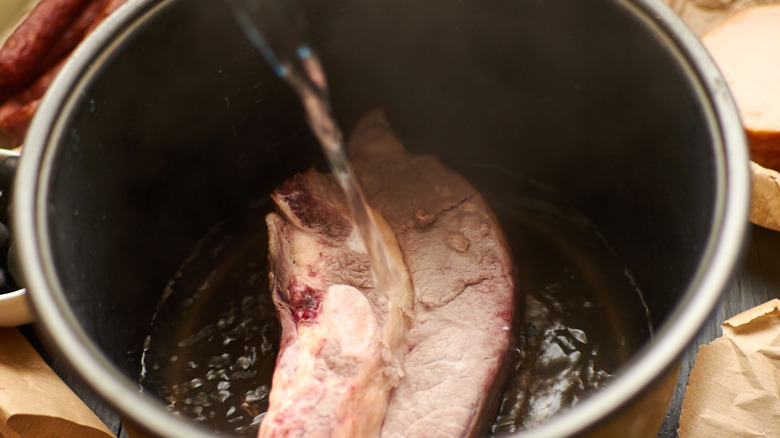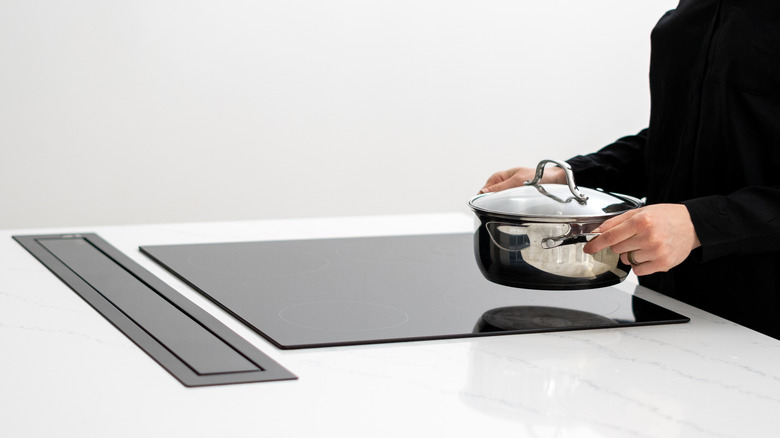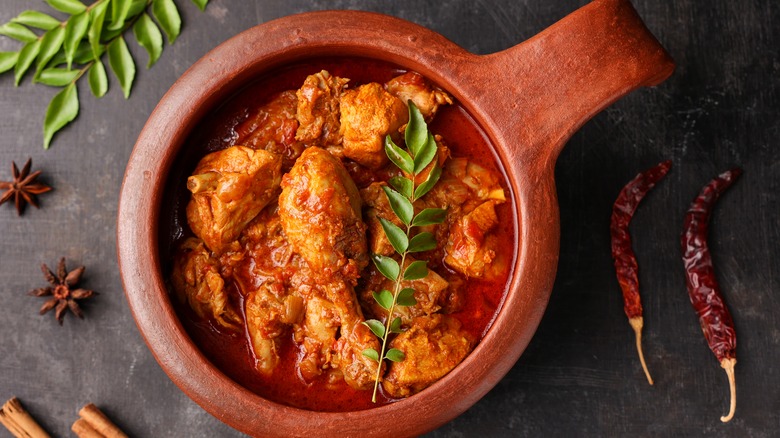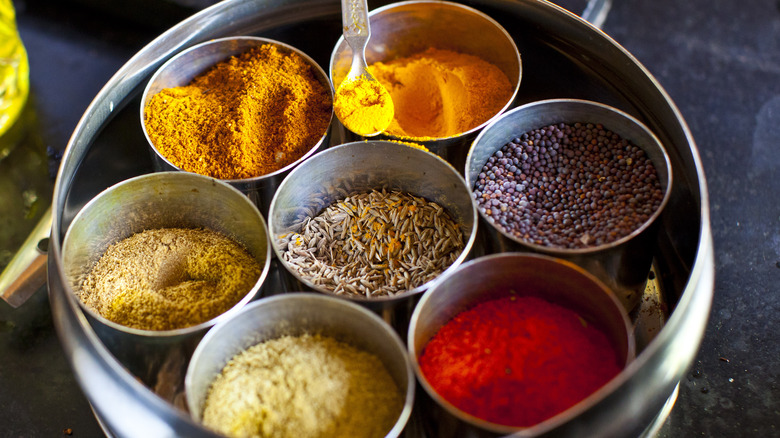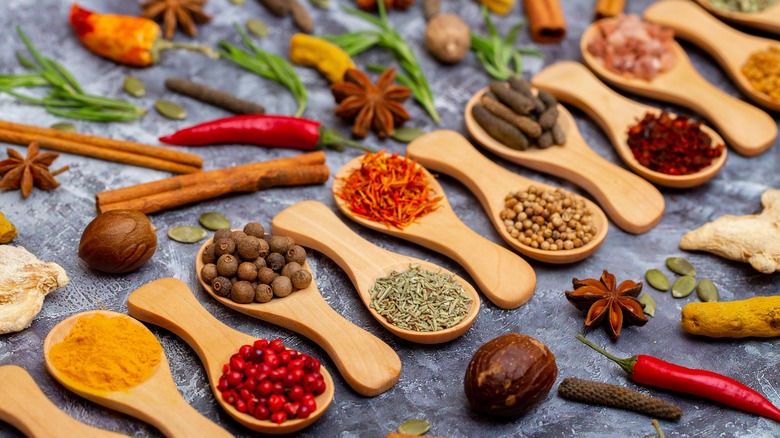Mistakes Everyone Makes When Cooking Curry
We Americans love our curries, the iconic Indian food that is usually the best-selling dish in every Indian restaurant. While the rich earthy, floral flavor of curry — coupled with hints of umami — is undoubtedly the primary reason curry is so popular worldwide, there's more to it. Per Healthline, the spices used in a typical curry have exceptional health benefits. Turmeric, for instance, can help lower inflammation in your body and prevent certain cancers. Similarly, cumin and coriander have fantastic antifungal and antibacterial benefits.
But here's the thing. Making curry doesn't mean simply tossing all the ingredients together in a pan and cranking up the heat. If you want a delicious curry, there are certain rules you must abide by. We've decided to discuss a few common mistakes you may encounter while making curry. By avoiding these mistakes, you can ensure that your culinary endeavors don't turn into a total disaster.
Over- or undercooking your onions
We can all agree that onions are a versatile vegetable. A must-have in the kitchen, they are one of the fundamental ingredients to making a delicious curry, and cooking them correctly is just as important.
According to Spice Pots, many recipe directions for making curry call for sautéing them, turning them a beautiful translucent color, and making them soft enough to incorporate easily into the curry. This short instruction may be adequate for pros, but too vague for amateur home cooks. So you'll either end up with a batch of undercooked onions or ones burned to char.
To cook them down to a T, start by cutting your onions. Make sure you dice them uniformly. Then add a pinch of salt to de-moisten them so they soften quickly. Add oil, butter, or a bit of both to a pan and leave them to heat up. Next, add your onions on medium heat. As they start to simmer, turn the heat on low and cover the pan.
As they cook, you can add a splash of water if they are sticking to the surface. Next, remove the cover and let the onions cook on medium heat for a minute or two until they look transparent enough.
You'll find these sautéed onions to have a sweetly mellow flavor that complements your mouth-watering curry. Cooking them just right makes all the difference in the world.
Not using ghee
If you're unfamiliar with ghee, we'll give you a bit of background. Ghee is a staple in most Indian cuisines. If you've had Indian takeaway, your taste buds know what we're talking about.
According to ABC Every Day, ghee is basically clarified butter drained from milk proteins and water. It's perfect for adding that nutty, buttery flavor to your dish. You can see why it will go oh so well with your curry recipe.
If you're trying to replicate the curry that you once had in that Indian restaurant, the key ingredient you're missing is probably ghee. While oil may work, it will lack the texture that ghee adds. Plus, it also works differently than other vegetable oils. This ingredient is a perfect medium to work with: It soaks up all the flavor of spices, and we know curry has a lot of spices in its list of ingredients.
If you love butter and want to cook it up at a high temperature, use ghee. This is because, unlike butter, ghee doesn't burn at high temperatures and won't taste unpleasant as you crank the temperature on your curry. Per a user on Reddit, the difference between oil and ghee is like night and day, the latter enhancing the flavors of a spicy dish tenfold.
Not making curry the day before
Curry is one of those magical dishes that transforms into an out-of-the-world cuisine overnight. When made in advance, curry reveals its authentic flavors; its potential to wow us increases infinitely, promising us a taste of heaven with every spoonful.
No spell or incantation is recited to make this happen. All of curry's components work together to bring out the fresh flavors, blooming and bursting with savory, spicy deliciousness.
What happens? Marination. We all know meat needs time to soak up flavors and yumminess. As the spices are in contact with the meat, all the flavor is absorbed, giving you a fresher kick of flavor that is less sharp but more palatable.
Additionally, the protein has a chance to break down, relax, and become a part of the delicious curry as it rests after being exposed to heat (via Curry Spy). There's also one more thing that happens when the curry is left to rest. The amino acids and sugar molecules in the food interact with each other when they come together in a pan. They become caramelized and experience pyrolysis, all of which contribute to the umami flavor of the meat.
According to Central Ask, when left overnight, spices in the curry have time to infuse, the sharpest of flavors mellow down, and subtle ones have time to become pronounced to give you a coherent taste. You can keep curry in the fridge for two to three days, and reheat it on a stovetop.
Using store-bought curry powder
To make a truly traditional Indian curry, you should toss the curry powder box in the trash. That's basically the first step. Instead, embrace whole, higher-quality spices and learn about what each one has to offer.
What's so bad about a store-bought powder? You'll find an astounding difference in consistency, texture, as well as flavor (store-bought powder having a milder, subdued flavor) than one which requires starting from scratch with effort and determination.
According to the Tampa Bay Times, when working with whole spices, you usually toss them in sizzling hot oil, which makes them burst — giving you a better, richer curry flavor with beautiful aromas. A Reddit user reiterates this by saying authentic Indian food doesn't use premade curry powders, and it's more of a British way of doing things. This is probably why your curry doesn't taste as good as the one you had at that Indian restaurant.
Yes, it's definitely hard work. However, the curry that results in this way more than makes up for it. After all, no pain, no gain, right?
Some popular whole spices you can cook an authentic Indian curry with include dried red chilis, coriander seeds, fenugreek seeds, cumin, and cardamom. While many restaurants that serve these types of cuisines usually strain them out from food, you can leave them in your curry. The spices will stew in it for longer and infuse their flavor. However, it's entirely up to you. There's no harm in doing either.
Not using the right beef cut
As crucial as ink is to pen, so is the right cut of meat for the curry. The wrong beef cut is synonymous with: tough, chewy, and "this is too hard for me to eat" curry. Some cuts of beef will tenderize so much that they'll dissolve within the curry. It is imperative that you choose a cut that goes with the cooking time of the curry.
So which one is the right cut? Well, as per Oven Via, the best cut of meat is the ever-loving chuck steak, which is derived from the shoulders. This lean piece has a lot of collagen, low fat on the surface, and marbling. This results in a curry brimming with flavor, savor, and deliciousness.
Steaks often come out tough if you've used low-quality stale meat and if you've undercooked or overcooked them. Make sure the steak cut you've chosen is not too lean either. To make your meat tender, Indian restaurants typically use yogurt to marinate their beef. This is actually a critical step in tenderizing the beef to soften it when it cooks.
A Reddit user, nomnommish, suggests doing a double marinade when cooking with tough meat. You can do the first marinate with yogurt, chili powder, and turmeric, and refrigerate for a day. And then add ginger, garlic, and green chili paste, and marinate for another four hours or so. Some people also use raw papaya to tenderize their meat.
Adding too much salt
Cooking curry is an art that takes practice to master. What would be a smart way to add salt? Add it in intervals in every dish.
Have you already added too much salt? Getting a numbing feeling in your mouth when you take a taste? We think that the dish we cooked with so much heart and effort has now gone to waste, but thank the kitchen gods, because there are some ways to salvage it. According to Slurp, you can try adding slices of raw potatoes to the dish. This will absorb the excess salt within 30 minutes.
You can also place a dough ball in the curry and bring it to a boil for three to four minutes. This will improve the flavor of your curry, in addition to removing the surplus salt. Another solution will be adding a blend of sugar and vinegar. Since sugar has a sweet taste and vinegar is sour, if both are added together with just a tablespoon each, it'll remove the taste of the overwhelming amount of salt that has been added. Raw but peeled onions also negate the taste of excess salt and saltiness.
We all have bread handy at home, yes? Then the problem is solved. Just add bread to your curry, and it'll soak up the plethora of salt, then you can discard the bread.
Adding too much water
It's quite a common occurrence in the kitchen that we add too much water into our dishes in the hopes that it will yield the perfect consistency, the thickness of gravy. Adding too much of it results in a runny curry with disparate flavor molecules, making it taste bland and boring.
While it's a matter of preference, some people prefer a thicker curry, while others like it a bit watery. That said, too much of anything can ruin the dish. Have you added too much water? The most effective way to treat this is to simmer the curry, but that takes a great deal of time.
Yogurt might be the miracle ingredient you're looking for (via Indian Kitchen & Spices). You can use it to thicken the curry, adding a rich and creamy taste. Or you can add some thickening agents like corn flour or rice flour. To avoid the lumps in your curry, mix the flour in water first, and whisk it well before adding it.
If you are going to add rice, just mix it in, and voilà, the curry won't even lose its nutrients or flavor. Using tomatoes to thicken the texture won't significantly alter the flavor of the curry, either. Put a tiny bit of tomato paste or tomato purée in the mix, making sure to add a small amount at a time until the curry reaches the desired thickness.
Not covering your pan
"If you like it, you should put a lid on it." If you like your curry to have an amazing, finger-licking taste, it's best to cook it with a lid.
Per Martha Stewart, you should keep the lids on if you want to keep the heat in, especially if you're simmering your spices or bringing the curry to a boil. Covering the pan saves time, energy, and effort. Also, it works super well to infuse all the flavors together to give you a coherent flavor palette.
Furthermore, if you want to maintain the consistency as well as the ratio of the liquid while cooking the meat simultaneously, it's best to leave your pan covered. Putting a lid on your pan ensures that the moisture is maintained; plus, braising the tough meat (like chuck steak) is the best way to go when making your curry. Keeping your pan covered is the way to do that since heat and moisture will break down the collagen and connective tissues to give you juicy, tender meat that will go really well with your curry. Make sure to avoid these common meat-braising mistakes.
According to a user on Reddit, keeping a lid on will also reduce cooking time as it traps the heat in, making the pot hotter. If you've added less water in the beginning while making your curry, it's best to keep it covered.
Not following the right order
A B C D ... G J H Z? What's wrong? Did we mess something up? Yup, the order's all messy. Well, that's what happens too when you don't follow the proper order of things when making your curry.
You can't just put everything in, cross your fingers, and pray it comes out smelling like heaven and tasting like the most delicious curry in the world. To make a curry, much less a perfect one, there is a particular sequence — an arrangement of sorts — to add the spices and ingredients. You must work and prepare it step by step, or you'll be charged with culinary blasphemy.
According to a user on Quora, Gautami Deshmukh, you have to work with whole spices. First, toss them in sizzling hot oil. The reason they go in first is that it takes time for whole spices to burst open and release their flavor as compared to the ground ones. The ground spices, on the other hand, are pretty quick to incorporate into the curry. Next goes in turmeric, followed by some wet ingredients like a vegetable. Lastly, you can add other types of ground spices like chili powder.
Garam masala and Kasuri methi are best added later, to top off the dish as a seasoning and so that they retain their lovely aromas. These often lure members of the family to the kitchen, as they wonder, "What smells so darn good?"
Adding garam masala toward the start
Psst, want to know a secret? Always add garam masala toward the end rather than at the start of cooking. That's a pointer no one else will tell you. It's one of the things we learned from Indian cooking.
Garam masala is a mashup of our favorite whole spices, like black pepper, bay leaf, cardamom, and cinnamon. It's a great way to add complexity and depth to your food and enhances the flavor profile times infinity. But why is it added toward the end?
Well, as per a Reddit user, garam masala is added later to "preserve" the aroma of spices. You'd think that adding it before would probably give it time to infuse the flavors properly in the curry, but you couldn't be more wrong. It would actually tone down the depth of the flavors. Conversely, adding them just before serving elevates the flavor of the dish.
Also, since curry is an Indian dish, it's best to follow their tradition when you're craving the taste of Indian cuisine. You can use whole spices in the beginning, but best to save the ground garam masala for later. Make sure not to add too much of it, or you'll end up with a bitter-tasting curry. Just a pinch or two will suffice.
Not roasting your spices
To roast or not to roast. That is never the question. Because for absolute perfection, you always need to roast your spices first.
Roasting whole spices is a tradition followed religiously in most Indian kitchens. They bring out a new world of flavors, adding depth and richness to your curry. According to Herbie's Spices, here's how to roast your spices: Start by heating your pan on a stovetop until you can touch the pan and say "hot damn." Next, add your spices and shake or stir them up, so they don't stick to the pan.
Then when they release their fragrance and oh-so-lovely aroma, it's safe to take them off heat. And voilà, you're done. A little word to the wise: It's better to roast your spices in a well-ventilated area, or the aroma can shoot up your senses and overwhelm you.
According to a user on Quora, Jai Kumar Ramachandran, roasting whole spices releases their essential oils, bringing out the aroma. And, when they are added to oil or ghee, all the fresh flavor transfers to it, enriching it with palatable taste and savoriness.
All that mouth-watering elixir sticks to the meat and vegetables you're cooking within the curry, increasing the flavors tenfold, and tempering with the taste of other ingredients. Roast and you'll get a stronger, sharper kick of flavor that'll probably make you wonder why you weren't doing this before.
